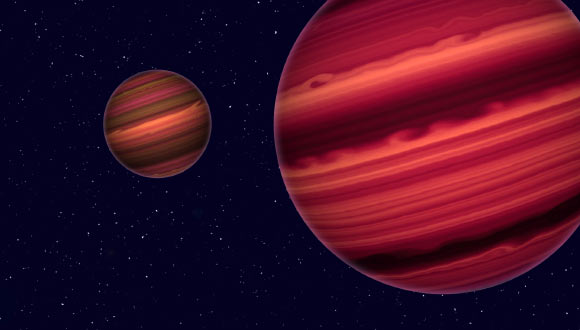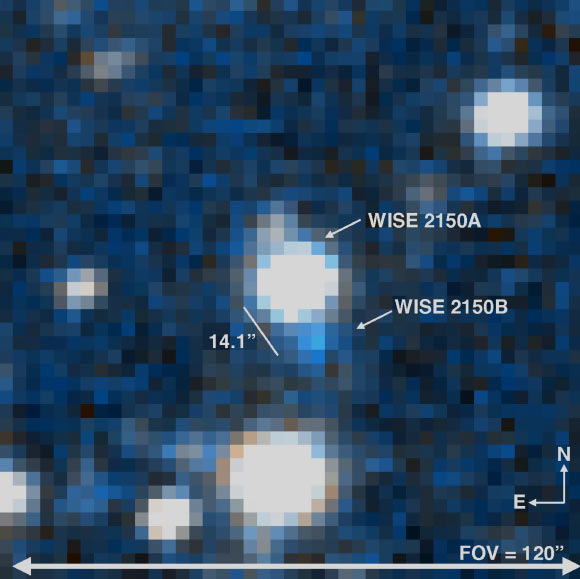Two Co-Moving Brown Dwarfs Spotted 79 Light-Years Away | Astronomy – Sci-News.com
Professional and amateur astronomers from the NASA-funded ‘Backyard Worlds: Planet 9’ project have spotted a co-moving pair of low-mass brown dwarfs in the solar neighborhood.

An artist’s rendering of two brown dwarfs. Image credit: Roberto Molar Candanosa & Sergio Dieterich, Carnegie Institution for Science.
To shine bright, stars need the energy derived from the fusion of hydrogen atoms deep in their interiors. If too small, hydrogen fusion can’t occur, so the object cools, darkens, and turns into something called a brown dwarf.
“On the high mass end, brown dwarfs overlap in observable properties with the coolest stars like TRAPPIST-1 which hosts seven terrestrial worlds,” said Dr. Jacqueline Faherty, an astronomer at the American Museum of Natural History, and colleagues.
“On the low mass end, they overlap with the observable properties of directly imaged exoplanets like 51 Eri b and Beta Pictoris b.”
“One of the most important and outstanding questions in substellar mass science is how these objects form and evolve,” they said.
“Co-moving companions are a key sub-population for investigating questions of formation.”
The newfound pair of brown dwarfs is older than 500 million years and younger than 10 billion years.
Designated WISE 2150-7520AB (W2150AB for short), it lies approximately 79 light-years away.
The system consists of two brown dwarfs of spectral types L1 and T8.
The primary member of the system, W2150A, has an estimated mass of 72 times that of Jupiter. The secondary member, W2150B, is 34 times heavier than Jupiter.
The distance between the two objects is around 341 AU (1 AU is the distance from the Sun to Earth).

This image shows the brown dwarf binary system WISE 2150-7520AB. Image credit: Faherty et al, arXiv: 1911.04600.
W2150AB was first spotted in data from NASA’s Wide-Field Infrared Survey Explorer (WISE) via the Backyard Worlds: Planet 9 project.
“The BackyardWorlds: Planet 9 project has been operational since February 2017,” Dr. Faherty and co-authors explained.
“The scientific goal of the project is to complete the census of the solar neighborhood (including the Solar System, e.g. Planet 9) with objects that are detectable primarily at mid infrared wavelengths and that were missed by previous searches.”
“Three citizen science users (Sam Goodman, Dan Caselden, and Guillaume Colin) brought to our attention a WISE W2 only detected source with significant motion,” the astronomers said.
“They used the Google form and emphasized the objects importance by emailing the Backyard Worlds distribution list as well as key researchers on our team. In addition, these users easily noted a bright source that appeared to be co-moving.”
The scientists then confirmed the discovery using the 6.5-m Baade Magellan telescope and the Folded-port InfraRed Echellette (FIRE) spectrograph.
“W2150AB resembles 2MASS J11011926-7732383AB (2M1101AB), the first brown dwarf binary discovered with a separation of over 20 AU,” they said.
“2M1101AB, discovered in the Chamaeleon star-forming region, was heralded as a source of definitive insight into the formation of brown dwarfs. But W2150AB leaves us with an intriguing question about whether it is an evolved version of 2M1101AB or perhaps a system that formed in a low density cluster that survived unperturbed by interactions with nearby stellar or giant molecular cloud.”
“Given that it is easily resolved with ground or space based observatories, W2150AB is an excellent benchmark system for understanding how brown dwarfs form and evolve together,” the researchers concluded.
Their paper will be published in the Astrophysical Journal.
_____
Jacqueline K. Faherty et al. 2019. WISE2150-7520AB: A very low mass, wide co-moving brown dwarf system discovered through the citizen science project Backyard Worlds: Planet 9. ApJ, in press; arXiv: 1911.04600






